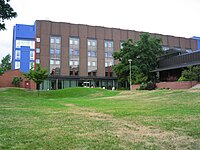Karolinska Institute
Karolinska institutet | |
| File:Karolinska logo.png | |
| Motto | To improve human health |
|---|---|
| Type | Medical University |
| Established | 1810 |
| President | Harriet Wallberg-Henriksson |
| Students | 5,500 (FTE, 2009)[1] |
| 2,100 (2009)[2] | |
| Location | , |
| Campus | Urban |
| Affiliations | LERU |
| Website | www.ki.se |





Karolinska Institutet (often translated from Swedish into English as the Karolinska Institute, and in older texts often as the Royal Caroline Institute) is a medical university in Stockholm, Sweden, and one of Europe's largest medical universities. According to the 2010 Academic Ranking of World Universities by Shanghai Jiao Tong University, the Karolinska Institute is the 42nd ranked university in the world and Sweden's highest ranked university. It is also Europe's highest ranked university in Clinical Medicine and Pharmacy and the only non-U.S. medical school ranked within the world's top 10.[3] In the Times Higher Education World University Rankings the Karolinska Institute ranked 29th on the list of Top 50 universities for Life Sciences and Biomedicine.[4] In 2010, according to University Ranking by Academic Performance (URAP),[5] it is the best university in Sweden and 30th university in the world.
The Karolinska University Hospital, located in Solna and Huddinge, is associated with the university as a research and teaching hospital. Together they form an academic health science centre. It is one of Sweden's largest centres for training and research, accounting for 30 percent of the medical training and 40 percent of the medical academic research conducted nationwide. While most of the medical programs are taught in Swedish, the bulk of the Ph.D. projects are conducted in English.
It was founded in 1810 on Kungsholmen island on the west side of Stockholm. Its main campus was moved decades later and located in Solna, just outside Stockholm, and a second campus more recently in Flemingsberg/Huddinge south of Stockholm.
A committee of the institute appoints the laureates for the Nobel Prize in Physiology or Medicine. The institute is a member of the League of European Research Universities.
History
Karolinska Institutet was founded in the period between 1810 and 1811, following the Finnish War, as a training center for army surgeons. The original name was at first 'Medico-Chirurgiska Institutet'.
In 1817 the prefix 'Karolinska' was added as a reference to the then Swedish king Karl XIII. The full name thus became 'Kongliga Carolinska Medico Chirurgiska Institutet'.[6]
In 1968 this name was changed to 'Karolinska Institutet'.
Notable alumni or faculty
- Jöns Jakob Berzelius (1779–1848; professor at KI), invented modern chemical notation and is considered one of the fathers of modern chemistry; discoverer of the elements silicon, selenium, thorium, and cerium.
- Carl Gustaf Mosander (1792–1858; student of Berzelius, his successor 1836), chemist, discoverer of the elements lanthanum, erbium and terbium.
- Gustaf Retzius (1842–1919), anatomist (Professor 1877-1890)
- Karl Oskar Medin (1847–1928), paediatrician, famous for his study of poliomyelitis (Professor 1883-1914)
- Ivar Wickman (1872–1914), pediatrician, pupil of Medin, polio expert
- Hugo Theorell (1903–1982), Nobel Laureate in Physiology or Medicine in 1955
- Torsten Wiesel (1924-), Nobel Laureate in Physiology or Medicine in 1981
- Pehr Edman (1916–1977), chemist (Med. dr 1946). Cf. Edman degradation
- Lars Leksell (1907–1986), physician, inventor of radiosurgery and the Gamma Knife.
- Sune Bergström (1916–2004), Nobel Laureate in Physiology or Medicine in 1982 (with Bengt I. Samuelsson and John Robert Vane).
- Bengt I. Samuelsson (b. 1934), Nobel Laureate in Physiology or Medicine in 1982 (with Sune Bergström and John Robert Vane).
- Ragnar Granit (1900–1991), Nobel Laureate in Physiology or Medicine in 1967.
- Göran Liljestrand (1886–1968), physiologist and pharmacologist.
- Ulf von Euler (1905–1983), physiologist, Nobel Laureate in Physiology or Medicine in 1970.
- Rolf Luft (1914–2007), professor, endocrinologist.
- Tomas Lindahl, cancer researcher and winner of the Royal Medal.
Departments of research (by location)
Campus Solna
- Cell and Molecular Biology
- Environmental Medicine
- Learning, Informatics, Management & Ethics
- Medical Biochemistry and Biophysics
- Medical Epidemiology and Biostatistics
- Microbiology, Tumor and Cell Biology
- Neuroscience
- Physiology and Pharmacology
- Woman and Child Health
Karolinska Hospital, Solna
- Clinical Neuroscience
- Clinical Science, Intervention & Technology
- Medicine, Solna
- Molecular Medicine and Surgery
- Oncology-Pathology
- Public Health Sciences
Campus Huddinge
- Biosciences and Nutrition
- Surgery, Huddinge
- Dental Medicine
- Laboratory Medicine
- Medicine, Huddinge
- Neurobiology, Care Sciences and Society
Other
- Clinical Science and Education, Södersjukhuset
- Clinical Sciences, Danderyd Hospital
Research at Karolinska
Researchers at Karolinska largely focus on medical and biomedical research in all disease areas.[citation needed] Particular strengths are in neuroscience, cancer biology, immunology, and metabolic diseases.[citation needed]
See also
- Stockholm University
- Royal Institute of Technology
- Stockholm School of Economics
- Sahlgrenska University Hospital
- List of universities in Sweden
- The New Karolinska Solna University Hospital, to be opened in 2015
References
- ^ Swedish Higher Education Authority (Högskoleverket) - Annual report 2010 (Swedish), page 106ff
- ^ a b "In brief 2009-2010" (PDF). Karolinska Institutet. 2009.
- ^ "Academic Ranking of World Universities". Shanghai Jiao Tong University. Retrieved 13 October 2010.
- ^ Times Higher Education 2009
- ^ "URAP - University Ranking by Academic Performance".
- ^ "KIs historia". Karolinska Institutet. Retrieved 17 July 2010.
External links
- Karolinska Institutet - Official site
- KI Community - Interactive internal website for scientists at Karolinska Institutet
